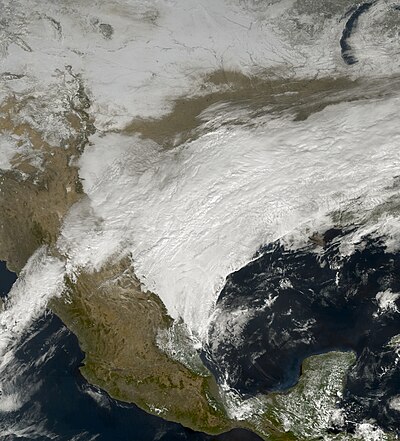
Search
January 31 – February 2, 2023 North American ice storm

An ice storm impacted the Southern United States in early 2023, bringing heavy snow and ice across the region. The Weather Channel reported that at least 10 deaths were attributed to the winter storm, which was unofficially named Winter Storm Mara by them.
History
The winter storm started when an Arctic cold passage made its way south into the Southern United States, where it met with warm and moist air from the Gulf of Mexico, creating the ice storm.
On January 31, an inch of sleet fell in the Tulsa, Oklahoma area, with the accompaniment of lightning at times. On the same day, freezing rain also fell in Arkansas, including the Fayetteville and Fort Smith areas, as well as Missouri, where cities such as Joplin and Springfield were impacted. Freezing rain and sleet fell as far south as Austin and San Antonio on January 31.
Preparations
Arkansas Governor Sarah Huckabee Sanders stated that she activated winter weather support teams from the Arkansas National Guard. Multiple schools and universities, including Texas State University and St. Edward's University, announced virtual learning and closures. DoorDash suspended operations in central Arkansas on January 31, while USPS also suspended operations in north Texas on that same day. Other companies, including Amazon, FedEx, and UPS were operating under a limited capacity. 60 warming shelters were opened in Texas. The funeral for Tyre Nichols was postponed for four hours. An NBA game between the Detroit Pistons and the Washington Wizards was postponed. At least more than 60 million people from New Mexico to West Virginia were under a winter weather alert.
Impact
Multiple media organizations reported ten deaths that were attributed to the winter storm, including seven in Texas, two in Oklahoma, and one in Arkansas. The National Centers for Environmental Information reported no deaths from this storm system. Numerous interstates, including interstates 10, 30, 35W, and 40 were shut down due to car accidents that were caused by the winter storm. Additionally, at least 100 car accidents were reported as a result. A total of 0.75 inches (1.9 cm) of ice accumulated in Fischer, Texas, while Kingsland, Texas received 0.67 inches (17 mm) of freezing rain. Dallas set a daily snowfall record on January 31, at 1.3 inches (3.3 cm).
In Texas, at least 350,000 people were left without power as a result of the storm due to tree limbs and power lines being brought down to ice. Of those 350,000 people, 160,000 were in Austin. This can be contrasted with Winter Storm Uri, wherein 4.5 million people were left without power due to, among other things, demand exceeding supply. On February 4, Governor Greg Abbott of Texas issued a disaster declaration for a seven county area.
At least 1,600 flights have been canceled, 888 of them in Dallas Fort Worth International Airport, with flights from Delta, United, Southwest, and American airlines being cancelled. At least 530,000 power outages were also reported. As of March 20, 2023, more than 166,000 tons of debris produced by the storm had been collected by the City of Austin.
See also
- February 2023 North American cold wave
References
Text submitted to CC-BY-SA license. Source: January 31 – February 2, 2023 North American ice storm by Wikipedia (Historical)
Articles connexes
- January 1998 North American ice storm
- February 13–17, 2021 North American winter storm
- January 31 – February 2, 2015 North American blizzard
- January 2009 North American ice storm
- February 2023 North American storm complex
- January 13–16, 2024 North American winter storm
- February 2022 North American winter storm
- Tornadoes of 2023
- January 2017 North American ice storm
- 2020–21 North American winter
- January 2007 North American ice storm
- 2023–24 North American winter
- 2011 Groundhog Day blizzard
- February 1983 North American blizzard
- Carrington Event
- January 2016 United States blizzard
- January–March 2014 North American cold wave
- List of ice storms
- February 2021 North American winter storm
- January 1999 North American ice storm
Owlapps.net - since 2012 - Les chouettes applications du hibou





